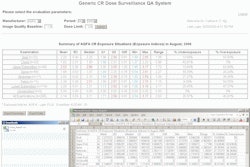An integrated radiation oncology telemedicine system has the potential to yield significant improvements in oncologic care, according to research from Memorial Sloan-Kettering Cancer Center (MSKCC) in New York City.
An MSKCC team found that physicians were more efficient at reviewing remote oncology cases using their internally developed telemedicine platform, which combines simultaneous display of sources such as live videoconferencing between physicians and physicists, radiology PACS, and treatment planning systems. In addition, the study team believes its use will lead to a reduction in clinical errors.
The system allows users to view multiple clinical components relevant to the patient's disease, all at the same time on one screen, according to a research team led by Dr. Boris Mueller.
"All of this visual information can be accessed by participants in real-time with zoom and edit capabilities," wrote the research team in the study abstract (International Journal of Radiation Oncology, Biology, Physics, October 3, 2009).
Mueller will describe his institution's experience with the integrated telemedicine platform for radiation oncology during a talk at next month's American Society for Radiation Oncology (ASTRO) meeting in Chicago.
The platform uses videoconferencing software and is able to access MSKCC's physics treatment planning system. These systems all function together over the institution's Ethernet network, enabling access to the institution's health information system, radiology PACS, physics treatment planning system, multiple shared network drives, and the Web, according to the MSKCC team.
To test the system, MSKCC performed a pilot study, outfitting two regional sites with a widescreen video monitor, dedicated computer, Web camera, and a headset with microphone. Each computer connects to MSKCC's Ethernet network and employs a Microsoft-based operating system.
Physicians at each MSKCC site reviewed a sample of prostate, breast, head and neck, and anal cases, accessing radiology images, radiation treatment volumes, treatment plans, and portal images. In addition, they performed side-by-side comparison of contouring techniques, with simultaneous display of a reference anatomy atlas, according to the researchers.
"The platform allowed physicians to remotely review details of each case efficiently," the authors wrote. "The interactions of the telemedicine platform improved clinical understanding of each case and often resulted in changes in contouring."
MSKCC plans to expand this platform into a "virtual tumor board," which would incorporate still images and videos of tumors, clinical procedures, pathology, archives of treatment-planning volumes, and anatomy databases, according to the researchers.
"The ultimate goal is to network physicians, physicists, and staff at MSKCC regional sites with the main campus to achieve an unparalleled level of interaction and more integrated care," the authors wrote. "This will facilitate interdisciplinary communication and contribute to a more comprehensive care of patients, beyond the limits of each specialization."
The researchers believe the telemedicine platform will also reduce clinical errors.
"From this experience, we feel that telemedicine could have significant clinical impact on oncologic care, especially at centers with distant satellite sites," the authors concluded."We plan to expand this proof-of-principle and accrue a clinically significant set of data to quantitatively study the advantages of this platform."
By Erik L. Ridley
AuntMinnie.com staff writer
October 19, 2009
Copyright © 2009 AuntMinnie.com




















